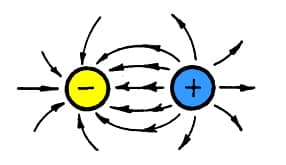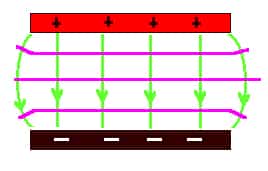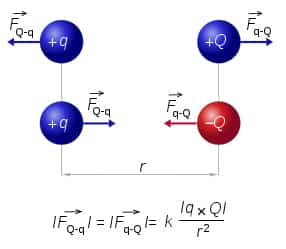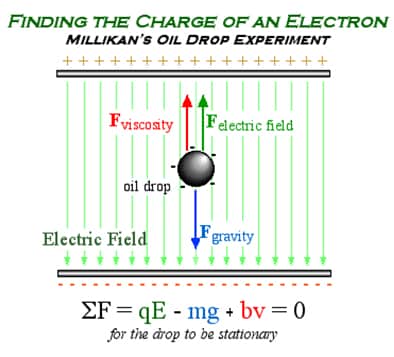Intrinsic property of particles that comprise matter
Point charge: charged particle with negligible size
Mass and charge are independent from each other
Positive Charge (q+) and Negative Charge (q-)
Coulomb’s Law
Magnitude of electric force between two charged spheres is proportional to the absolute amount of charge on each sphere, and is proportional 1/r2 where r is the distance between the spheres.
Standard unit for charge is Coulomb (C)
K= 1/ (4 x pi x e0) e0= permittivity of vacuum (8.85 x 10^-12 C2/ (N x m2)
ε0, commonly called the vacuum permittivity, permittivity of free space or electric constant, relates the units for electric charge to mechanical quantities such as length and force.
*Important difference between mass & charge: CHARGE IS QUANTIZED (charge MUST be a multiple of elementary charge) elementary charge: 1.6x 10^-19 C
Proton: +1.6x 10^-19 C Electron: -1.6x 10^-19 C Neutron: 0
MILLIKAN EXPERIMENT
- Oil droplets where sprayed into the chamber.
- Many of which carry a charge due to the friction of leaving the nozzle.
- The droplets sink due to their weight.
- Eventually they stopped falling due to the balance of weight and electric forced upwards.
The elementary charge could then be determined!
Electric force: is determined by 1) relative positions of two point charges, the signs of the charged of the two interacting particles.
Fel= (|q1| x |q2|) = (4 x pi x e0 x r^2)
(9.0×10^9 Nxm^2/ C^2) x |q1| x |q2|)/ R^2
So the direction of electric force based on the sign of the point charges (+)(+) AWAY, (-)(-) AWAY, (+)(-) TOGETHER!
We study: static electrical fields!
We refer to all mobile point charges as stationary point charges, which we used to determine stationary electrical field!
Electrical Field
 Fel= qmobile x E (electrical field= E in N/C V/m)
Fel= qmobile x E (electrical field= E in N/C V/m)
***Static Electrical field acts in ALL directions it is a VECTOR but NOT a force! It points in every direction.
AWAY from the positive single point charge TOWARD the negative point charge!
At every position within an arrangement of stationary charges the stationary electrical field is the force vector that acts on a mobile point charge of unit charge if placed at that position.
Therefore a negative charge will feel a force in the direction of the field (PULL IN) and a positive charge will feel a force in the opposite direction of the field (PUSH OUT)
Point charges don’t actually need to be present to measure electric field, it predicts capacity of current arrangement to do work.
The electric field is a vector field with SI units of newtons per coulomb (N C−1) or, equivalently, volts per metre (V m−1). The SI base units of the electric field are kg·m·s−3·A−1. The strength or magnitude of the field at a given point is defined as the force that would be exerted on a positive test charge of 1 coulomb placed at that point; the direction of the field is given by the direction of that force.
 Stationary electrical charge: |E|= (1/ 4 x pi x e0) x (qstationary)/ r^2
Stationary electrical charge: |E|= (1/ 4 x pi x e0) x (qstationary)/ r^2
FACT: electrical field of a dipoles drops proportional to 1/r^3, MUCH faster than a single charge, 1/r^2
Electrical dipole moment (μ= q x d)
Surface Charge Density= ơ= Q/A (units: C/m^3)
Electrical Field of Charged Parallel Plates: |E|= ơ/ e0 (**if asked to calculate |E| at only one plate do ơ/e0x2)
The direction of the electrical field between charged parallel plates is independent of the position and is proportional to the area charge density of the plates. The direction of the field is uniform and the |E| vector point in ALL directions. Perpendicular to the positive plane!
Electrical Energy
Is a SCALAR! Can be used to determine total work; electric energy is a potential energy!
Electrical Potential
The electric energy of a mobile point charge in a parallel plate arrangement is a linear function of distance from the plate that carries a charge with opposite sign of the mobile charge.
**If you move a charge total a plate of the same polarity (W is POSITIVE) force must be exerted to displace it, otherwise work is negative.
∆V= (ơ x b/ e0) -> potential difference is proportional to the surface charge density and linear (ơ= q/A) potential difference is also proportional to q
Electric potential is the energy required to move a unit of electric charge to a particular place in a static electric field!
Calculating Electric Potential
Separate electrical energy into: mobile point charge and field due to all stationary point charges in the system. Field is a SCALAR FIELD
Volt= J/C (energy per charge)
***potential doesn’t matter, but the difference in potential needs to be considered!
Potential increases when we follow a line that moves from an area with negative charges to an area with positive charges. The electric field point in the direction of decreasing potential.


